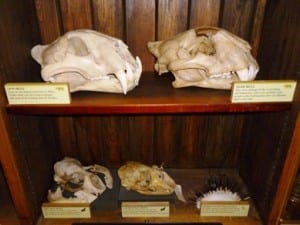Can museums lie?
By Jack Ashby, on 5 December 2011
Can we lie about what a specimen is or where it came from?
Would it make a difference to you if we deliberately mis-labelled a specimen? If we wrote interesting factual labels about common seals, but used a grey seal skull in the display, would you care if you found out? The facts would still be true. What if we said the specimen was from Britain when the specimen actually came from Denmark?
This is the newest QRator question we are asking through one of our ground-breaking iPad displays. It’s something we’re really interesting in hearing what you think, so please do get involved in the conversation.
LIES OR HALF-TRUTHS?
None of these specimens have been correctly identified, but all of the facts are true. Should we only tell facts about species in the Museum?
NORTH AMERICAN PORCUPINE QUILLS
Porcupine quills are modified hairs loosely attached to the skin. Porcupines are one of the largest rodents in North America.
LION SKULL
Lions are the largest carnivores in Africa. Unlike other cats, they hunt in groups, with most of the hunting done by females.
TIGER SKULL
This cat is endangered due to poaching and habitat loss. There are probably more
people in this building than there are Siberian
tigers in the wild.
GREY SEAL SKULL
40% of all grey seals live in UK waters. Their Latin name means “hook-nosed sea pig” and they can grow to over 3m long.
COMMON SEAL SKULL
Also called harbour seals, they are the smaller of the two British breeding seals. They feed mainly on fish, crustaceans and molluscs.
What do you think? Get involved in the conversation on the QRator website, and come and visit to see the display for yourself.
One Response to “Can museums lie?”
- 1
 Close
Close



[…] this practice wrong? We’re currently asking whether it is okay for museums to lie in one of our QRator cases and recently I posted about intellectual transparency in CGI […]